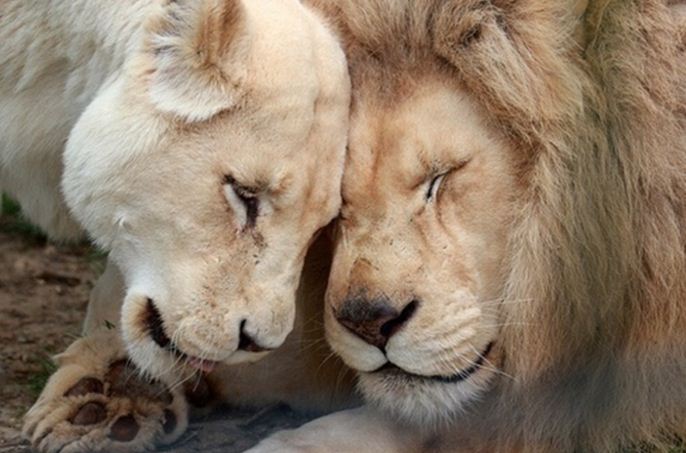By Journey man
The success of the Gir National Park is not in just being a good national park where lions have been preserved well and their numbers are growing. It is also the only place in the world outside Africa where a lion can be seen in its natural habitat. If any national park or site in China says it also has lions, then there is catch to it: exactly the catch through which it has promoted the increasing numbers of Siberian Tigers, for example. But that is another story. Gir is a natural success.
The lions of Gir are majestic animals, averaging 2.75 m in length, and with a bigger tail tassel, bushier elbow tufts and prominent belly folds than his African cousin which has a larger mane. After Africa, perhaps Gir National Park is the only place where one can see a great number of lions – Asiatic lions – roaming freely. This is a great addition to the park in general, which is home to 40 species of mammals and 425 species of birds.
Of course, there are a huge number of other, elusive wild animals and hard-to-find birds like uncommon Asiatic wild ass, hyenas, Gir foxes, pygmy woodpecker, brown fish owl and black buck etc.


This variety has promoted the national park as an esteemed wildlife destination in India and has attained an immense popularity among travellers, wildlife lovers, photographers, nature enthusiasts, researchers and hunters. Travellers come from all across India and from abroad.
Only home to Asiatic lions
One has to remember that the Gir National Park is the only home to Asiatic Lions in the wild. There are only around 600 Asiatic lions left in the wild, and all live here. The population largely lives in the protected park area of the Gir Forest National Park and Sanctuary.
The lions live closely alongside humans in their last remaining natural habitat, including the Maldhari community, who live within the Gir Forest. Some of the lion population live outside of the protected areas, amongst local communities in the surrounding farmland and hills.
Conservation support
The good news is that poaching is not a problem in the Gir Forest at the moment. This is thanks to dedicated and skilled forest rangers. However, it is always a potential concern with such precious wildlife. Experienced NGOs have worked with the Gir’s rangers to implement a new patrol based monitoring system to give staff clearer and more scientific data on what is happening in the protected area, helping to identify threats and monitor activity.
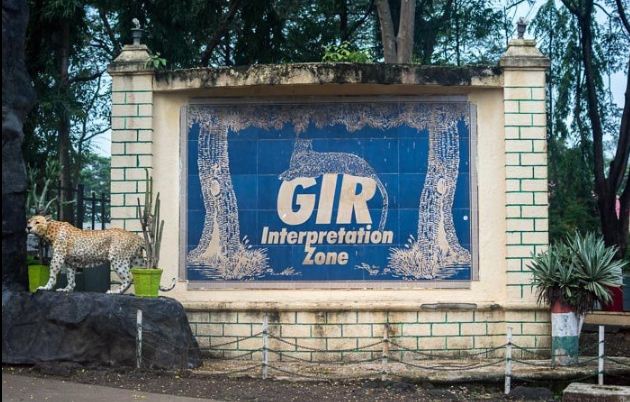

They have what is called a SMART (Spatial Monitoring and Reporting Tool), developed by conservation organisations, and is a combination of software, training materials and patrolling standards to establish effective patrolling systems, monitor wildlife populations and movements and identify threats such as poaching or disease.
History
This great national park is situated approximately 65 km south east of Junagarh district. The government notified the large geographical extent of Sasan Gir as a wildlife sanctuary on September 18, 1965 in order to conserve the Asiatic lion. It covers a total area of 1412 square km, of which 258 km forms the core area of the National Park. Indiscriminate hunting by the people of Junagarh led to their decrease in population drastically, while they were completely wiped out from the other parts of Asia.
It was the kind effort of Nawabs of Junagarh who protected the queen royalty in his own private hunting grounds. Later in the course of time o0ffocials from the forest department came forward to protect the world’s most threatened species. From a population of approximately 20 lions in 1913, they have risen to a comfortable 523 according to the 2015 census. There are 106 male, 201 female and 213 sub-adult lions in the wilderness of these four districts.


The hunting days
During the 19th century, the kings and rulers of India invited the British colonists for hunting expeditions. It is said that they did so in order to maintain good trade, power, and political relations with the British. However, by the end of the 19th century, the deliberate consequences of these cruel activities showed up.
As a result, at the end of the 19th century only about a dozen Asiatic lions were left. The Gir Forest was considered the hunting grounds of the Nawab of Junagarh and British officials. They were responsible for the drastic fall in the number of lions. Due to this, until today, the forest area of Gir National Park is considered one of the most important and protected areas in Asia.
Gir National Park is a beautiful park, dotted with deciduous forests, interspersed with semi-evergreen and evergreen flora, acacia, scrub jungle, grasslands and rocky hills, along with an abundance of fauna. Sprawling over an area of 1,412 sq km, the park is one of the most charming national parks in India.
Data to represented the No. of Asiatic Lion
| Year | Adult Male Female | Sub adult | Cubs | Total | |
| 1990 | 99 | 95 | 27 | 63 | 284 |
| 1995 | 94 | 100 | 39 | 71 | 304 |
| 2001 | 101 | 114 | 57 | 55 | 327 |
| 2005 | 89 | 124 | 72 | 74 | 359 |
| 2010 | 97 | 162 | 75 | 77 | 411 |
| 2015 | 109 | 201 | 73 | 140 | 523 |
| 2020 | 159 | 262 | 115 | 138 | 674 |
Early conservation
In the early 1900s, constant trophy hunting had reduced the count of lions to just 15-20. When the British viceroys brought this matter to the attention of the Nawab of Junagadh, the Nawab ensured the protection of the park. Lord Curzon, especially, requested the Nawab to conserve the lions. Thus, the forest area of Gir and its lions were declared as protected by the Nawab. A ban was also imposed on the shooting of lions.
The conservation history of Gir National Park also includes other factors that make conservation of the park essential. Gir is the largest compact track of dry deciduous forest in the semi-arid western part of India. It has the maximum number of carnivores, and also has the largest population of marsh crocodiles in the country. The park provides shelter to all these forests and animals.
THE ATTRACTIONS AT SASAN GIR
Animals
The entire forest area of the Gir National Park is dry and deciduous which provides best habitat for Asiatic Lions. As per the new statistics of 2015, the entire Saurashtra Region is inhabited by 523 Lions and more than 300 leopards. Apart from these two animals the park is a home to two different species of deer. The sambar is the largest Indian Deer. The Gir forest is also known for the chowsingha – the world’s only four horned antelope. The Jackal, striped hyena and Indian fox are some of the smaller carnivores found in Gir forest.
Birds
There are various types of Gir Birds that are found in Sasan Gir national park. Sasan Gir is an extremely sensible place for bird-watching. Sasan Gir holds three hundred lions with leopards, that makes one in all the big-cat concentrations in India. Cervus unicolor and chital, nilgai, chousingha, Indian antelope, and swine thrive in Gir. Jackal, hyena, jungle cat, rusty-spotted cat, langur, porcupine, black-naped Indian hare are different mammals of Gir. The Gir national park has a variety of 250 birds and 50 different species which are vulnerable.
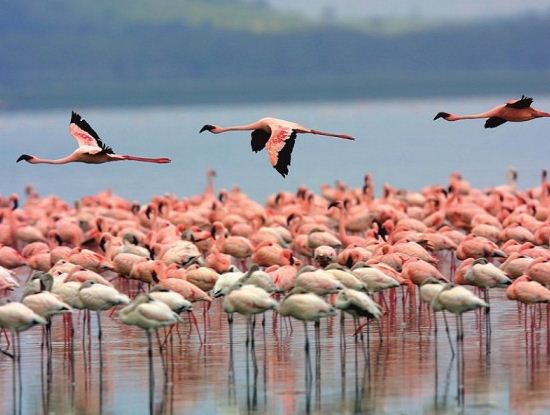

If you are a nature and birds lover then you will love to see the birds of gir forest. There are many species like sand grouse, grey francolin, quails, Asian paradise flycatcher, black-naped monarch, grey-haired flycatcher, verditer flycatcher, Tickell’s blue flycatcher etc.
Reptiles
Sasan Gir is blessed with more than 40 species of reptiles and amphibians. Kamleshwar – a large reservoir in the sanctuary is the best spot where Marsh Crocodiles can be seen in large numbers. The park even has many species of snake including the King Cobra, the Russell’s viper, saw-scaled viper and the krait.
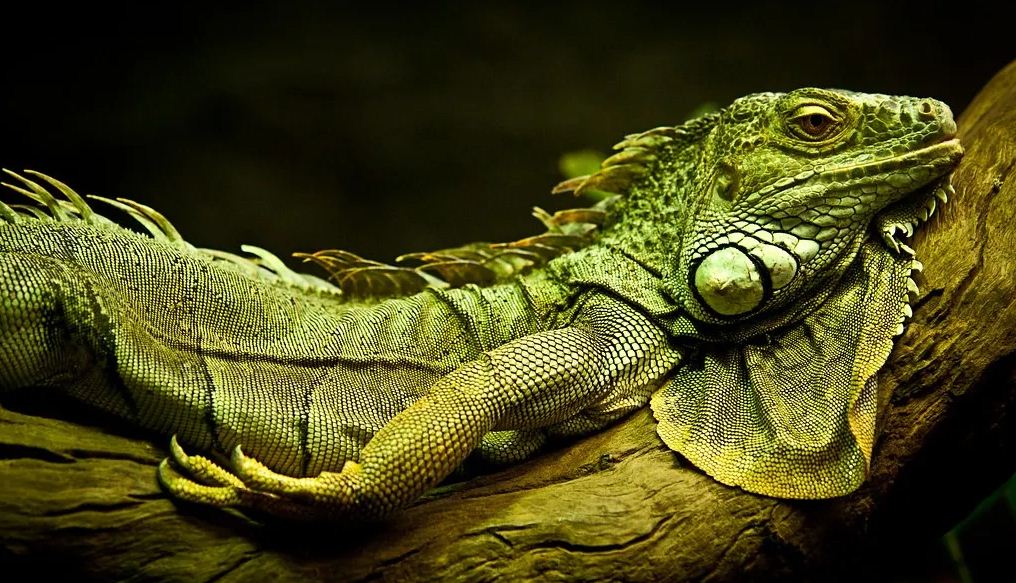

The star tortoise and freshwater turtles could also be seen in the sanctuary. It also has a large population of marsh crocodiles and other reptiles which include star tortoise, soft-shelled turtle, monitor lizards and the Indian rock pythons. The crocodile hatchery at Gir is also an interesting place to see.
How to Reach Gir National Park
By air: The nearest airports to the Gir National Park are Keshod airport and Rajkot airport. The Keshod airport is located around 70 km from the park, whereas the Rajkot airport is at a distance of around 160 km.
By rail: Junagadh and Veraval railway stations are the nearest railway station from the Gir national park, located at around the same distance from the park. Both the railway stations are on the main railway line of the state and connected to all the major locations of the country by direct trains.
By road: The roadways travelling is always an appealing journey and the best than any other commuting option. The conditions of the roads in Gujarat are comparatively good and the road journey can be comfortable and enjoyable in the state. The Gir National Park is properly connected to most of the prominent cities of Gujarat via a good road.
Best Time to Visit:
The Protected Area in Gir is closed for tourists in the monsoon season from June 16 to October 15 every year. The winter months of December to March are a good time to visit Gir, as the weather is pleasant. However, the summer months of April and May, even though very hot, are the best months for viewing and photographing the wildlife in Gir.
Popular places to see in Gir
Gir Interpretation Zone, Devaliya: In order to reduce human interference in the main area of Gir National Park, and facilitate tourists to better understand the importance of Gir and its varied wildlife, an interpretation zone has been developed at Devalia. It comprises 412 hectare of chain-link fenced area which represents Gir in a short, including all habitat types and all major wildlife present in the main sanctuary area. The basic idea behind creating this facility is to offer an opportunity to view lions and other wildlife species in their natural habitat in a short time and pressure on the main sanctuary area will be reduced.
This interpretation zone has a healthy population of prey base in the form of Sambars, Chinkaras, Wild Boars, Blue Bulls and Spotted Deer. This fenced area is a treat to the eyes for wildlife enthusiasts.
Devalia Safari Booking
·In every slot of jeep safari ride only 10 jeep are allowed by the forest department
·In a single permit only six person can visit Gir Interpretation Zone
·Permit is issued purely on first come and first serve basis
·One can obtain permit 3 months before the exact date of your travel date
·Do not forget to carry your ID proof in original, it is mandatory while making entry at the gate
· Please carry the same ID card that you produced at the time of booking
·Please note that on the spot booking for Devalia Safari Booking is not possible
·Once the permit is issued alteration or modification is not possible
How To Reach Devalia Safari Park
Devalia Safari Park Gir is easily accessible on all three modes of transportation. One can reach Devalia by following routes.
By Road: Devalia Safari Park is situated approximately 56 km from Junagarh. The main city of Ahmedabad is located at a distance of 374 km and 158 km from Rajkot. The reception centre is at Devalia Park & Sasan Gir and it also has a forest guest house maintained by the Gujarat state forest department nearby the railway station.
By Rail: Tourists can reach Devalia by rail mode of transport too. You can travel by rail to Junagarh from Ahmedabad or Rajkot and then take a 55 km road trip on bus or taxi to Devalia Safari Park or can come via local trains from Junagadh city up to Sasan Gir village. Local trains run frequently between Ahmedabad and Junagadh and Rajkot and Junagadh.
By air: The nearest airport is Rajkot and Ahmedabad. From the airport you may need to hire a private taxi/cab to reach Devalia safari park.
Kankai safari in Gir National Park
The Kankai Temple basically originated from Shri Kankeshwari Mataji or in short Kankai Mataji temple. This place of worship is 25 km away from the Sasan Gir. It is also said that the goddess here is addressed as the rescuer of propels wandering a propos in the Gir forest. The Kankai Mata temple lies inside the Gir National Park which is perfect for wildlife wanderlust. Tourists can also experience lion thunder within the temple.
Kankai Jungle Safari – Kankai jungle safari is allowed to only those tourists who have taken the official permit from Gir Forest Official. The safari to this Kankai forest will let you experience the enthralling experience of wildlife. The adventure will be in full swing and you will encounter the best appearance of flora and fauna along with the wild animals view.
The Kankai safari timing and entry fees: Rs 7,000.
– Morning: 6.30 am to 12 am
– Afternoon: 1:00 pm to 6:00 pm
Permit for Night Stay
Avail the permit from the forest official for staying here at night. Only 50 tourists at a time can stay at night. All sorts of visitors are required to have the permit to enjoy Kankai safari and to enter the temple.
Jeep Safari In Sasan Gir
Safari is organized by the state forest department which is of approximately 3 hours inside the core area of the Park. Tourists going inside the park are accompanied by a forest department approved jeep driver and guide during open jeep safari. Boarding point for the safari is “Sinh Sadan”. Travellers need to report to Sinh Sadan at least 30 minutes prior to schedule Safari time.
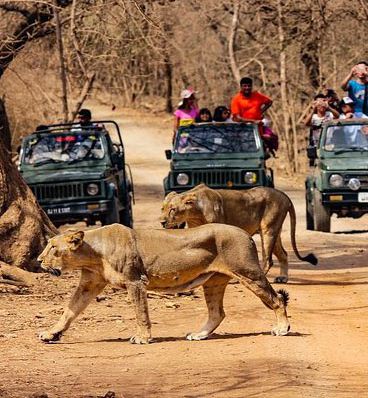

While you are on Jeep Safari, you can spot the lions in their natural habitat, when they are on the prowl. Watching the lions from an open-roof jeep is altogether a wonderful experience. During your jeep safari, you can also click some pictures of the lions. Best time to spot the lions are at dusk and dawn. Jeeps and guides are made available by the Forest Department.
Where to stay near Gir national Park
Good standard hotels and resorts in the surrounding area of any wildlife sanctuary play an important role in the promotion of tourism in the state. In the last couple of years many new hotels and resorts have been established for this specific purpose. The Gir hotels are amazing in some way, whether it is architectural design or natural setting. These beautiful properties are all equipped with modern luxury and amenities that are much-needed during a tourist’s vacation.
Gir Birding Lodge
Gir birding lodge is built exactly at Gir wildlife sanctuary entrance. The big mango orchard is around the lodge giving an amazing appearance to it. During your stay in Gir Birding Lodge, you will get accommodation in two different sorts of standard rooms which are in Lodge’s main building. The lodge provides deluxe rooms/ cottages that are well furnished with necessary amenities like an attached bath with hot and cold shower supply and western fitted toilets.
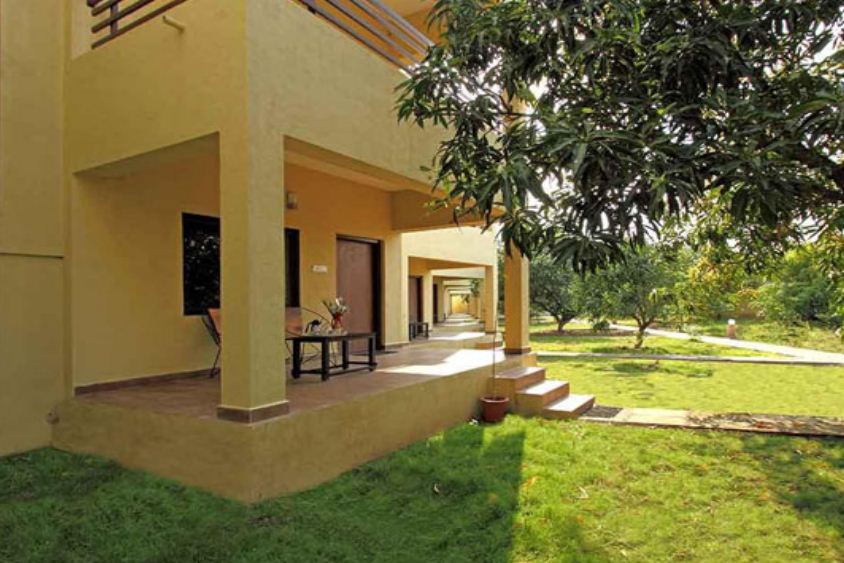

The guests find extreme comfort while staying in cottages and rooms here as these are surrounded by Kesar Mango groves of beautiful Gir hills. The vegetation at Gir birding lodge ensures the presence of numerous birds around.
Gir Birding Lodge Fact Sheet : It is an intimate lodge of only 6 cottages and 14 rooms. Rejuvenating outdoor and dining venues. Yoga, Meditation, and wellness programs are conducted. 17-acre mango orchard. Nature walks and birding at the lodge. There are 20 Deluxe Rooms. Traditional Indian veg and non-veg meals are served.
Amidhara Resort
Located amidst hills, Amidhara Resort is one of the most beautiful and prestigious hotels in Gir. It is a vast resort, set up in 1412 sq/km in deciduous forests, grassland, evergreen flora, and acacia scrub. It is very close to the famous Gir National Park, so for tourists of this park, this resort would be an ideal place to get accommodation during their trip. For making tourists feel comfortable while they stay, the resort offers amazing services and amenities. You may get AC or Non AC rooms that depend on individual choice. Apart from it, there are many other notable things that make Amidhara resort so popular among the masses like indoor activities, outdoor game arrangements, swimming pool, multi cuisines restaurant, and conference hall. Here, you can choose your accommodation in standard rooms, deluxe rooms, super deluxe rooms, family rooms, or even cottages.
The Amidhara Resort is in a tranquil and peaceful location. Here tourists are offered a variety of rooms that cater to different types of requirements requested by guests. The resort makes perfect arrangements for different needs like family rooms, marriage parties, couple rooms, conferences, etc. Apart from room accommodation, you may get jungle safaris arrangements from Amidhara Resort.

